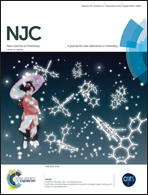Recognition and determination of multi-metal ions based on silver nanoclusters capped by polyethyleneimine with different molecular weights†
Abstract
Ag nanoclusters templated by hyperbranched polyethyleneimine (PEI) with different molecular weights have been developed as a new fluorescent platform for the sensitive and selective recognition of Hg2+, Cu2+, Co2+ and Ni2+ based on fluorescence quenching of the Ag nanoclusters. This sensing system shows good linear ranges and lower detection limits: the linear ranges are 0.1 nM to 10 μM for Hg2+, 0.1 nM to 20 μM for Cu2+, 1 nM to 20 μM for Co2+, and 1 nM to 30 μM for Ni2+; the limits of detection for Hg2+, Cu2+, Co2+, and Ni2+ are estimated to be 35 pM, 28 pM, 0.33 nM, and 0.30 nM, respectively. In addition, the different molecular weights of PEI reveal little effect on the sensitivity and linear ranges of detection. Most importantly, by adding different masking agents, the presence of Hg2+, Cu2+, Co2+ and Ni2+ could be selectively quantified without interference from other metal ions, for instance thymine was used for masking Hg2+, potassium pyrophosphate for masking Cu2+, nitrilotriacetic acid for masking Co2+ and dimethylglyoxime for masking Ni2+. On this basis, not only the content of a single type of metal ion but also the total amount of metal ions could be readily detected, which would further improve the convenience and practicability of metal ion sensors. Furthermore, this sensing system has been applied successfully for the detection of Hg2+, Cu2+, Co2+ and Ni2+ in real water samples.


 Please wait while we load your content...
Please wait while we load your content...